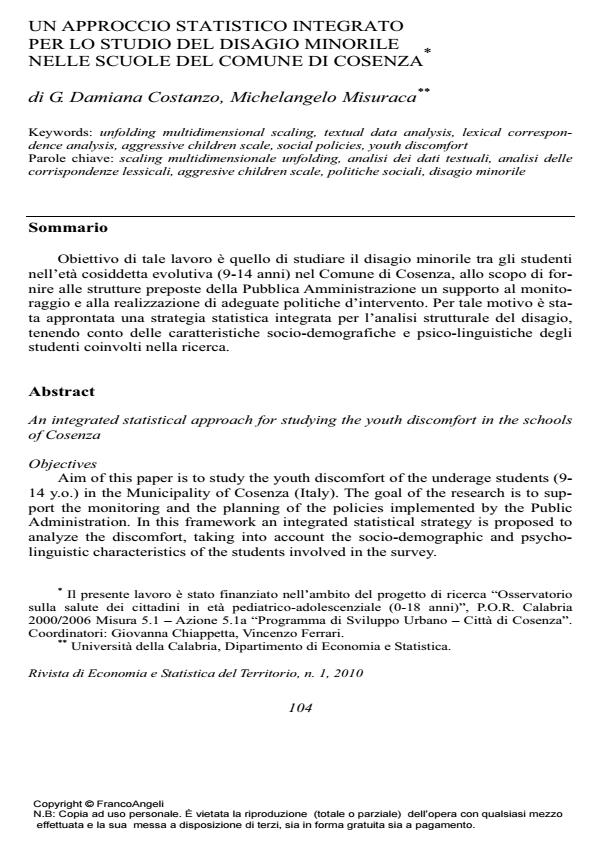Un approccio statistico integrato per lo studio del disagio minorile nelle scuole del Comune di Cosenza
Journal title RIVISTA DI ECONOMIA E STATISTICA DEL TERRITORIO
Author/s G. Damiana Costanzo, Michelangelo Misuraca
Publishing Year 2010 Issue 2010/1
Language Italian Pages 19 P. 104-122 File size 757 KB
DOI 10.3280/REST2010-001004
DOI is like a bar code for intellectual property: to have more infomation
click here
Below, you can see the article first page
If you want to buy this article in PDF format, you can do it, following the instructions to buy download credits

FrancoAngeli is member of Publishers International Linking Association, Inc (PILA), a not-for-profit association which run the CrossRef service enabling links to and from online scholarly content.
An integrated statistical approach for studying the youth discomfort in the schools of Cosenza Objectives Aim of this paper is to study the youth discomfort of the underage students (9- 14 y.o.) in the Municipality of Cosenza (Italy). The goal of the research is to support the monitoring and the planning of the policies implemented by the Public Administration. In this framework an integrated statistical strategy is proposed to analyze the discomfort, taking into account the socio-demographic and psycholinguistic characteristics of the students involved in the survey. Methods and Results The proposed methodology is developed in a multivariate statistical framework. A particular questionnaire known as ACS (Aggressive Children Scale for Social Programs on Prevention) with 83 closed and open-ended items has been administered to 1635 students. A two-steps integrated strategy is used. A joint representation of the latent proximity relationships between the units and between the items is obtained by first performing an Unfolding Multidimensional Scaling, achieving a typology of the respondents. In the second step by using Lexical Correspondence Analysis it is possible to describe the different categories in terms of shared vocabulary. The Unfolding Multidimensional Scaling results suggest that the youth discomfort varies along two dimensions: active and passive discomfort, presence and absence of discomfort. On the basis of these differences youth discomfort seems to fall mainly into three distinct categories, by considering aggressive, unsuited and not discomforted subjects. The Textual Analysis has highlighted that the language among the three categories is more homogeneous in the younger subjects, and that the dissimilarities increase with the age, even if this relation is more evident for the female subjects. Moreover in the word space it is possible to see how a verbal aggressiveness (active or passive) characterizes female subjects, while a physical aggressiveness (active or passive) characterizes male subjects. Conclusions The proposed strategy seems to be suitable in detecting the differences in the youth’s behaviors, pointing out the different types of discomfort. The automatic language analysis, performed on the open-ended items, adds a characterization of the different categories traditionally taken into account in a qualitative approach but not ever used in a quantitative background, underlining in such way the invisible mass of social universe. The results can be usefully considered in an intervention and prevention policies planned at different levels: Municipalities, School Districts, and so on. Clearly an expert knowledge support, e.g. in the domain of sociolinguistics and psychology, would allow a better and complete interpretation of the latent relations underlying the discomfort study.
Jel codes: C19, C80, H75
G. Damiana Costanzo, Michelangelo Misuraca, Un approccio statistico integrato per lo studio del disagio minorile nelle scuole del Comune di Cosenza in "RIVISTA DI ECONOMIA E STATISTICA DEL TERRITORIO" 1/2010, pp 104-122, DOI: 10.3280/REST2010-001004